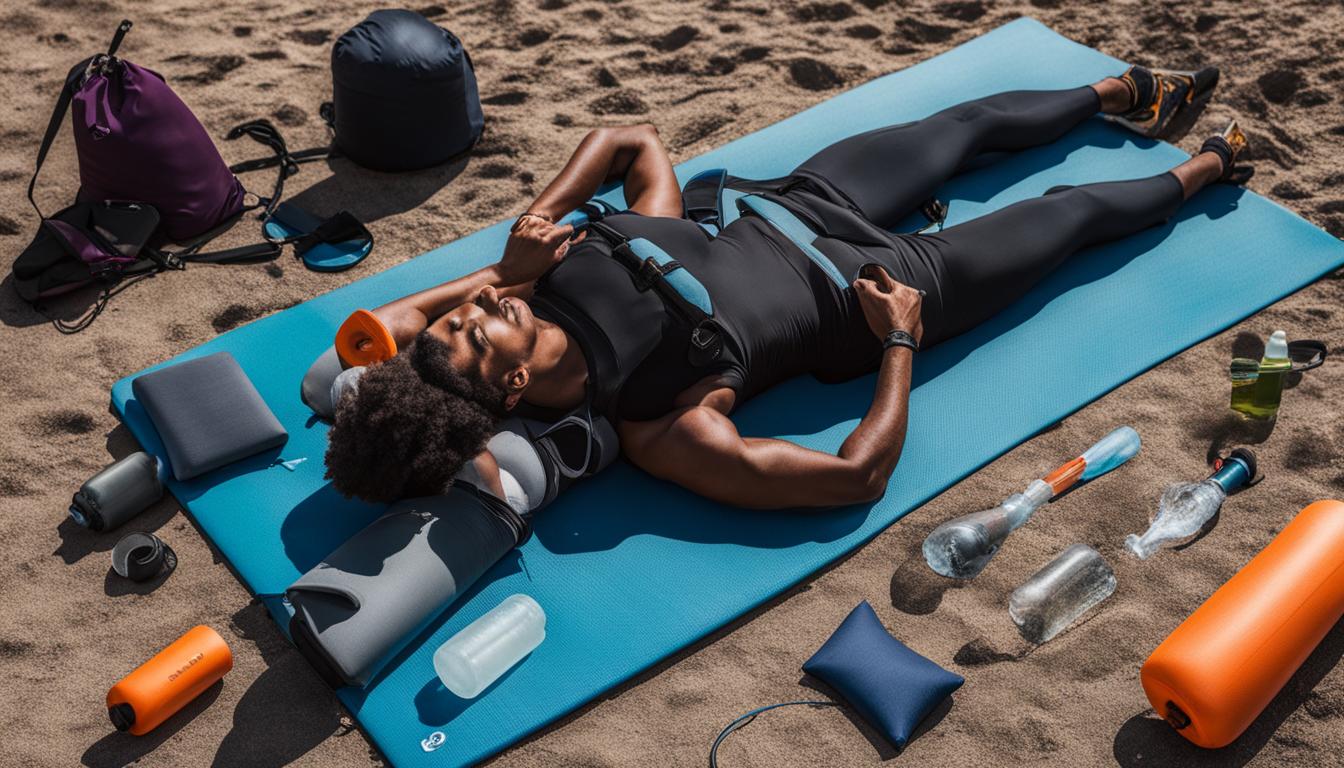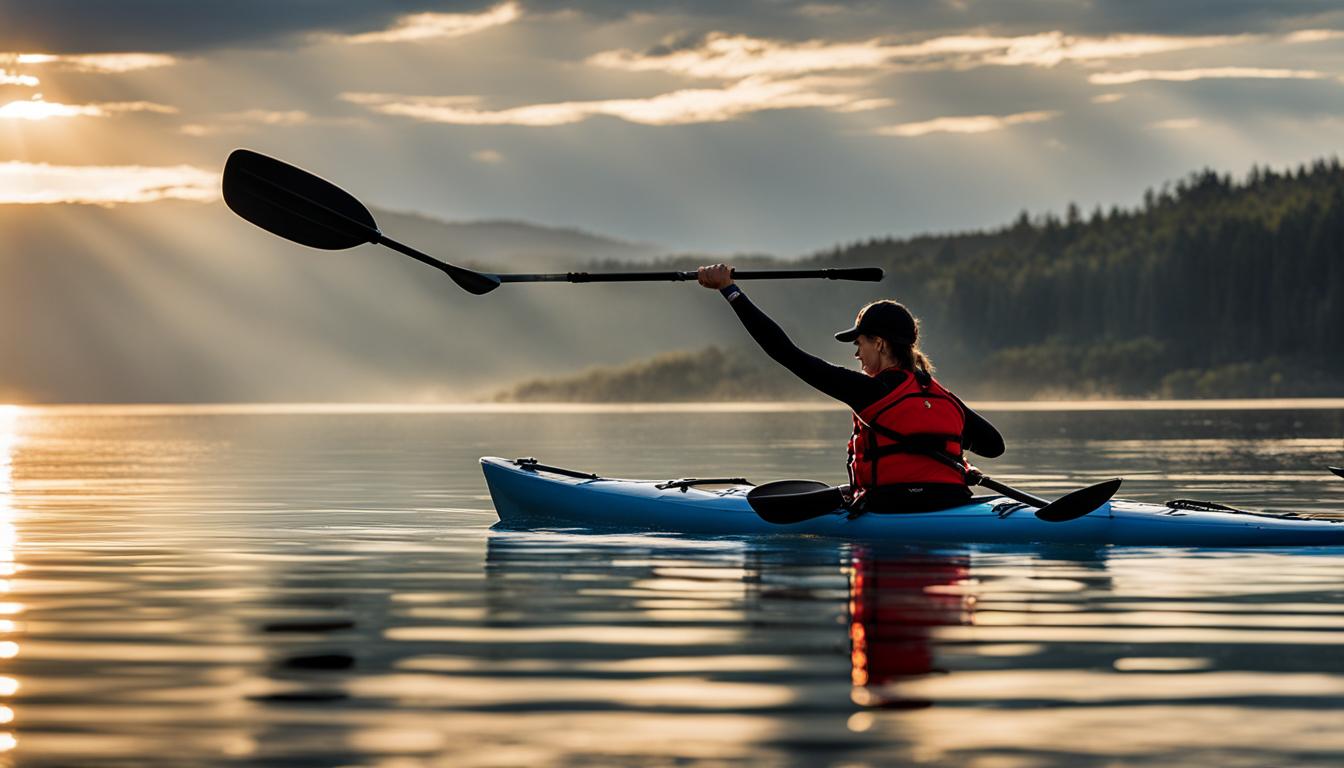After a strenuous kayaking session, it is crucial to prioritize recovery to prevent injuries and improve performance. Balancing rest and intensity is key to avoid overexertion. Here are some best practices for kayaking recovery routines based on expert advice:
Key Takeaways:
- Rest and recovery are essential for preventing injuries and improving performance in kayaking.
- Proper recovery strategies can help enhance stamina and prevent overtraining.
- Cool down exercises after paddling promote muscle recovery and prevent stiffness.
- Incorporating soothing recovery practices can help relax the body and promote rejuvenation.
- Listening to your body and adjusting your recovery routines based on individual needs is crucial.
The Importance of Recovery in Kayaking Endurance
When it comes to kayaking endurance, recovery plays a crucial role in enhancing your performance and preventing overtraining. By incorporating effective recovery strategies into your routine, you can improve stamina, reduce the risk of injuries, and maximize your paddling potential.
One of the key recovery strategies for paddlers is to prioritize rest and allow your body time to recover between intense kayaking sessions. This means taking regular breaks from paddling and ensuring you get enough sleep each night. Sleep is essential for muscle repair and growth, as well as overall physical and mental recovery.
In addition to rest, kayaking-specific recovery workouts can also contribute to improved endurance. These workouts focus on strengthening the muscles used during kayaking, improving flexibility, and enhancing overall fitness. Incorporating exercises such as core strengthening, upper body strength training, and cardio workouts can help you build the necessary endurance for long kayaking sessions.
“Proper recovery is just as important as the kayaking itself. It allows your body to adapt and become stronger, ultimately improving your endurance and performance on the water.”
Furthermore, it’s crucial to fuel your body with the right nutrients to support recovery. This includes consuming a balanced diet rich in lean protein, complex carbohydrates, and healthy fats. Proper hydration is also essential for replenishing fluids lost during kayaking and aiding in muscle recovery.
By implementing these recovery strategies and incorporating kayaking-specific recovery workouts into your routine, you can optimize your endurance and take your kayaking performance to the next level. Remember to listen to your body, adjust your recovery routines based on your individual needs, and consult with a professional trainer or coach for personalized guidance.
| Recovery Strategies for Paddlers: |
|---|
| 1. Prioritize rest and get enough sleep. |
| 2. Incorporate kayaking-specific recovery workouts. |
| 3. Fuel your body with a balanced diet. |
| 4. Stay hydrated and replenish fluids. |
Effective Post-Paddling Cool Down Exercises
After a vigorous kayaking session, it’s important to prioritize post-paddling cool down exercises to promote muscle recovery and prevent stiffness. These exercises can help reduce muscle soreness, increase flexibility, and improve overall performance. Incorporating these effective cool down exercises into your routine can make a significant difference in your recovery process.
1. Upper Body Stretches
To release tension and prevent muscle tightness in your upper body, perform a series of stretches. Start by extending your arms overhead and gently reaching towards the opposite side, holding the stretch for 15 to 30 seconds on each side. This stretch targets the muscles in your shoulders and upper back. Next, clasp your hands behind your back and slowly raise your arms while keeping them straight. Hold this stretch for 15 to 30 seconds to target your chest and shoulders.
2. Lower Body Stretches
Give your lower body the attention it deserves by performing stretches that target the hip flexors, quads, hamstrings, and calves. An effective stretch for the hip flexors involves lunging forward with one leg while keeping the other leg extended behind you. Hold the stretch for 15 to 30 seconds on each side. To stretch your quads, stand tall and pull one foot towards your glutes, holding the stretch for 15 to 30 seconds. For the hamstrings, sit on the ground with your legs extended in front of you and gently reach towards your toes. Hold the stretch for 15 to 30 seconds. Lastly, stand facing a wall or tree, and place one foot a few feet behind the other. Bend your front knee and lean forward to stretch your calf muscles. Hold the stretch for 15 to 30 seconds on each leg.
3. Foam Rolling
Incorporating foam rolling into your post-paddling cool down routine can help relieve muscle tension, improve circulation, and enhance recovery. Focus on rolling the muscles that were engaged during your kayaking session, such as your back, glutes, quads, and calves. Apply gentle pressure and roll back and forth along each muscle group for about 1-2 minutes. Remember to breathe deeply and listen to your body, adjusting the pressure if needed.
By including these effective post-paddling cool down exercises in your routine, you can speed up your muscle recovery, reduce the risk of injury, and maintain optimal performance during your next kayaking adventure.
Soothing Recovery Practices for Kayakers
After intense kayaking sessions, it’s crucial to prioritize soothing recovery practices to relax your body and promote rejuvenation. These practices can help you recover effectively and prepare for your next adventure on the water. Incorporate the following relaxation routines and rejuvenation exercises into your post-kayaking routine to maximize your recovery:
1. Stretching for Relaxation
Engaging in gentle stretching exercises after kayaking can help release tension in your muscles and increase flexibility. Focus on stretching your shoulders, back, arms, and legs to target the areas that are most engaged during paddling. Hold each stretch for 15-30 seconds and remember to breathe deeply throughout the stretches. Stretching not only promotes physical relaxation but also helps calm the mind.
2. Deep Breathing and Meditation
Deep breathing exercises and meditation can aid in reducing stress and promoting relaxation. Find a quiet spot, sit comfortably, and close your eyes. Take slow, deep breaths, inhaling through your nose and exhaling through your mouth. Focus on the sensation of your breath and let go of any tension or thoughts that arise. Practice deep breathing and meditation for a few minutes each day to enhance your overall well-being and promote mental clarity.
3. Hydrotherapy
Hydrotherapy involves the use of water for therapeutic purposes and can be a wonderful way to relax your muscles after kayaking. Take a warm bath or shower to soothe your body and promote blood circulation. Alternatively, consider using a cold ice pack or ice bath to reduce inflammation and relieve muscle soreness. Hydrotherapy can be a refreshing and rejuvenating practice to incorporate into your recovery routine.
| Relaxation Routine | Rejuvenation Exercise |
|---|---|
| Stretching for Relaxation | Gentle stretching exercises targeting key muscle groups |
| Deep Breathing and Meditation | Deep breathing exercises and mindfulness meditation |
| Hydrotherapy | Warm baths, cold ice packs, or ice baths |
Remember, recovery is just as important as training when it comes to kayaking. By incorporating these soothing recovery practices into your routine, you can relax your body, promote rejuvenation, and ensure you’re ready for your next kayaking adventure!

Conclusion
In conclusion, prioritizing recovery practices for kayaking endurance is essential for maintaining physical well-being and enhancing performance on the water. By incorporating rejuvenation exercises into your routine, you can optimize your body’s ability to recover and improve your overall kayaking experience.
One of the key aspects of effective recovery is stretching. Performing gentle stretches after kayaking sessions helps release tension in your muscles and promotes flexibility. This can help prevent injuries and ensure that your body is ready for the next adventure.
Hydration and nutrition are also vital for recovery. Drinking plenty of water throughout the day and consuming nutritious foods replenishes the fluids and nutrients lost during paddling. It supports your body’s recovery process and aids in muscle repair.
Rest and relaxation should not be overlooked. Giving yourself sufficient time to rest allows your body to recover and rebuild. Incorporating relaxation practices such as deep breathing exercises, meditation, or even a warm bath can further promote rejuvenation and reduce stress.
Remember, everyone’s recovery needs are different, so listen to your body and adjust these practices accordingly. By following these recovery principles, you can continue to enjoy longer and stronger kayaking adventures while minimizing the risk of injury and maximizing your performance potential.
FAQ
Why is recovery important after kayaking?
Recovery is crucial after kayaking to prevent injuries, improve performance, and enhance endurance. It allows the body to repair and rejuvenate, reducing the risk of overexertion and overtraining.
What are some key points to consider for kayaking recovery?
Some key points to consider for kayaking recovery include incorporating cool down exercises, maintaining proper hydration and nutrition, getting enough rest, and practicing relaxation techniques.
What are some effective post-paddling cool down exercises?
Effective post-paddling cool down exercises include gentle stretching, foam rolling, and performing low-impact exercises like walking or cycling to promote muscle recovery and prevent stiffness.
What are some soothing recovery practices for kayakers?
Some soothing recovery practices for kayakers include taking warm baths or showers, using a foam roller or massage tools to release tension in muscles, practicing yoga or meditation, and getting quality sleep.
How can recovery practices enhance kayaking endurance?
By prioritizing recovery practices such as stretching, hydration, proper nutrition, rest, and relaxation, kayakers can recover effectively, reduce the risk of injuries, and optimize their performance, leading to enhanced kayaking endurance over time.





